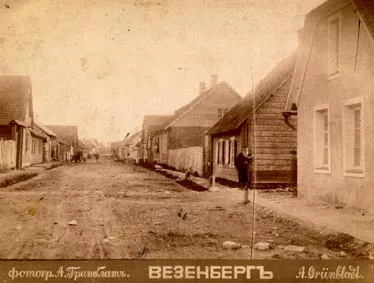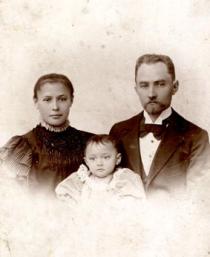This is the street where my paternal grandparents lived. The second to the right is the wooden house of my grandfather. My grandfather, Tsvi-Girsh Sorkin, is standing by the house. Rakvere, Photographed by Grinblat, 1890s.
My father's family lived in a small Estonian town, Rakvere, located 100 kilometers away from Tallinn. Rakvere had a very advantageous geographic position. The roads to Tallinn and Petersburg were through the town. In 1866 two Jews came to Rakvere, which was called Viesenberg at that time. My parental grandfather, Tsvi-Girsh Sorkin, was one of them and the other one was his companion, Aaron-Eadle Friedman. At that time Jews were banned to live in Rakvere as there was a Jewish Pale of Settlement in tsarist Russia, but both of the arrivals were good tinsmiths, having five years of experience. Besides, tinsmiths were in demand in Rakvere and not only in the town. There were large estates in the whereabouts of the town and experienced tinsmiths were needed there, so they were permitted to settle in the town. I also heard that apart from them there were other Jews in Rakvere, Cantonists, who served in the tsarist army, but I do not know if that was true.
Actually my grandfather and his friend started the Jewish settlement in Rakvere. In the late 1880s there were 100 Jewish families in Rakvere. It is known that in 1870 the Jews of Rakvere were permitted to open a Jewish town cemetery. The reason for that was the death of two Jews - Cantonists. They were buried in the Jewish cemetery in Rakvere. My grandfather Tsvi-Girsh Sorkin was buried there next. He died rather young, in 1894. Grandmother died in Rakvere in 1903. She was buried next to Grandfather in the Jewish cemetery of Rakvere in accordance with the Jewish rite.
I do not know exactly how my grandmother Tsive-Feiga came to Rakvere. I supposed she got married to Grandfather and went there with him. I do not remember where they lived before their arrival in Rakvere.
The family lived in their own house. It was a spacious one-storied wooden house. The synagogue was in front of the house. It was a large, two-storied synagogue. Men prayed on the first floor and women - on the second.


















